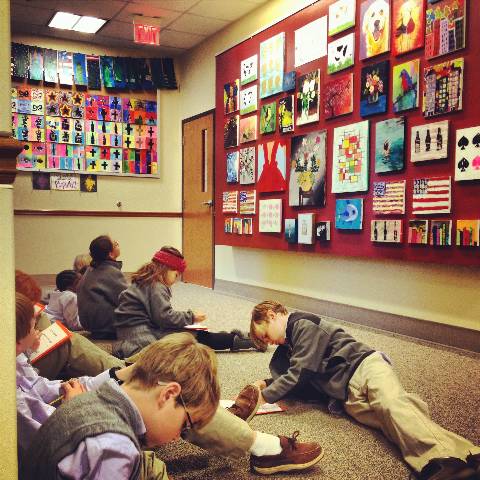If you visit the art room in Thatcher Hall, you will see a variety of works created by our students on display on a rotating basis. We are in the process of building a gallery of sorts that showcases the range of skills we are learning and talents we are nurturing.
It has been so enlightening to listen to the conversations that our artwork has sparked among middle school students. I love seeing them pass by my room as they go to lunch, walk to break, or just change classes. All of a sudden, they will stop and talk with their friends about the work on display. There are no phones in hand and no need for texting. They are having real, meaningful conversations, in person, about art! And to hear what they are saying is just as exciting as the fact that they are "tech-free" and "talking" to each other.
All of the observations of student conversations about our artwork made me realize that it was a great time to introduce a critique to my third- and fourth-grade classes. They marvel at the art on display every time they come to art class. So when the fourth grade came to art class today, I met them in the hall with their sketchbooks and pencils. The looks that they were giving me were priceless. They have a routine and are so used to our morning sketch time that this was throwing them for a loop. I loved it.
Once they all arrived, we sat down on the floor, facing the art display outside our room. I began to explain that critiquing art is part of the artistic process. A person can critique a poem, a story, or a piece of music as well. We talked about the difference between criticism and constructive criticism. I tried to explain that art is subjective and the reasons that a person likes a piece of art will be different from the reasons that his friend likes another piece of art.
We discussed how a person can be drawn to a particular style or piece of art, for different reasons. The work might conjure up a memory, have colors that the person loves, be soothing, feel exciting, or just speak to a person's heart. We talked about this for a few minutes and then I handed out a critique form and instructed the students to select one piece of art on display to critique. Our critique form was appropriately named, "The Art Sandwich". There were three parts to it and the student was allowed to elaborate on as much as he or she felt was necessary.
Part one was the bread. Students wrote one or more sentences describing something that they liked about the piece they were critiquing. I encouraged the use of art vocabulary terms and the elements that we have learned. Some examples I gave were, "Is it the use of complementary colors that you like? Do you like the artists' use of warm colors or geometric shapes? Does the piece have depth and look realistic to you?" I wanted them to realize that they have the ability to "talk about art" in an educated way. They know what they like and need to be encouraged to express it. They also need to use the art language they have learned to justify their reasons for liking the piece.
Part two of our sandwich was the meat. Students were asked to offer suggestions of improvement or change for the artist. I stressed that this was each student's opinion and, again, that art is subjective. I also encouraged them to base their suggestions on the artistic elements and principles that we have learned. For example, "The artist could have added more texture to this part of the painting. Darker shading would give dimension to the piece. Patterns with lines or color would create variety in the painting."
Our last section was the bottom piece of bread. Students were asked to describe something else that drew them to this particular piece. I reminded them to look at the colors, textures, shapes, direction of lines, and other elements that made the piece special to them. This part of the critique was used to express more of the emotional connection that they might have experienced with the piece.
After we finished the critique, the class was eager to get to work on the Folk Art pictures. As I was reading over their critique responses, I could hear new conversations. These 4th grade students were asking each other about color combinations, patterns and even suggestions, for their own art while working. They were thinking. Once again, I loved it.
We have a long way to go in this very subjective and delicate process of critiquing art. As we navigate our way through it, my hope is foster a love for art and a confidence in them about loving it.

